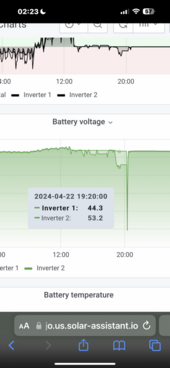Nobodybusiness
Collecting the leftovers of the Great Sky Reactor.
Had a situation last night.
Just got in the house 7:30 pm.
Turn on lights and suddenly power went out.
I knew we weren’t running any heavy loads.
Went out to the inverter and the DC breaker going to master inverter was tripped.
Reset everything and got it back up.
Look at SA and saw something weird.
Inverter 1 voltage dropping while inverter 2 stay the same.
Remember no heavy loads.voltage just dropping on inverter 1 but not 2 and both going to same battery bank through midnight Solar combiner.
Each inverter has 250 amp Carling ( midnight) breaker at the combiner.
The voltage starting dropping few minutes before we got home to lowest I see is about 42v then the breaker tripped.
Not sure what to make of it.
No shorts or breaks in the 4/0 copper cable.
When I reset breaker it appears fine.
Just got in the house 7:30 pm.
Turn on lights and suddenly power went out.
I knew we weren’t running any heavy loads.
Went out to the inverter and the DC breaker going to master inverter was tripped.
Reset everything and got it back up.
Look at SA and saw something weird.
Inverter 1 voltage dropping while inverter 2 stay the same.
Remember no heavy loads.voltage just dropping on inverter 1 but not 2 and both going to same battery bank through midnight Solar combiner.
Each inverter has 250 amp Carling ( midnight) breaker at the combiner.
The voltage starting dropping few minutes before we got home to lowest I see is about 42v then the breaker tripped.
Not sure what to make of it.
No shorts or breaks in the 4/0 copper cable.
When I reset breaker it appears fine.




